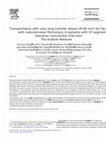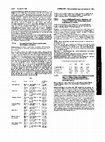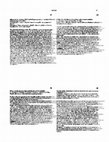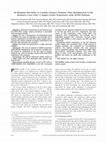Papers by Stanislaw Bartus
Kardiologia Polska, 2013
Kolegium Redakcyjne "Kardiologii Polskiej" składa serdeczne podziękowania recenzentom prac nadsył... more Kolegium Redakcyjne "Kardiologii Polskiej" składa serdeczne podziękowania recenzentom prac nadsyłanych do naszego pisma. Wszystkim poniższym Osobom szczerze dziękujemy i, pomijając ich tytuły naukowe, drukujemy pełną listę recenzentów za rok 2012. Tę tradycję chcemy utrwalić, dlatego też podobną listę znajdziecie Państwo za rok, w numerze styczniowym pisma w 2014 roku, a będzie dotyczyć recenzentów "Kardiologii Polskiej" w 2013 roku.

International Journal of Cardiology, 2010
Background: The majority of ST-segment elevation myocardial infarction (STEMI) patients are admit... more Background: The majority of ST-segment elevation myocardial infarction (STEMI) patients are admitted to centers without primary percutaneous coronary intervention (PCI) facilities. Purpose of the study was to determine safety and outcomes in STEMI patients with transfer delay to PCI N 90 min receiving half-dose alteplase and abciximab before PCI (facilitated PCI with reduced-dose fibrinolysis). Methods and results: Outcomes of 669 STEMI patients (b 12 h chest pain, non shock, fibrinolysis eligible, b75 years) with transfer delay to PCI N 90 min who received half-dose alteplase and full-dose abciximab and were immediately transferred for PCI were compared with primary PCI effects in 1311 patients with transfer delay b 90 min. Mean time from symptom-onset to PCI was longer (357 ± 145 min vs. 201 ± 177; P b 0.001) in facilitated PCI with reduced-dose fibrinolysis group. In-hospital and 12-month outcomes were similar in both groups, however bleeding events were more frequent in facilitated PCI group (hemorrhagic stroke 0.9% vs. 0%; P b 0.001; severe + moderate 5.5% vs. 2.3%; P b 0.001). Conclusions: This is the first large report showing the safety and benefits of transportation with very long transfer delay (N90 min) for facilitated PCI with reduced-dose fibrinolysis in STEMI patients. In fact, pharmacological treatment (combotherapy) was effective in overcoming the deleterious effects of long time-delay on outcome, with similar survival as compared to short-time transportation, despite higher risk of major bleeding complication.
International Journal of Cardiology, 2008
The coexistence of peripheral artery disease (PAD) and multilevel atherosclerosis increases death... more The coexistence of peripheral artery disease (PAD) and multilevel atherosclerosis increases death and stroke rates in patients with coronary artery disease (CAD). These patients are often treated conservatively without revascularisation of inferior limbs. We included 66 consecutive patients with complex CAD diagnosed by coronary angiography. All patients underwent percutaneous coronary intervention (PCI) for non-ST elevation acute coronary syndrome (NSTEACS) before

Journal of Cardiovascular Medicine, 2008
Catheter-delivered device in closure of atrial septal defect (ASD) by Amplatzer septal occluder (... more Catheter-delivered device in closure of atrial septal defect (ASD) by Amplatzer septal occluder (ASO) is a feasible alternative to surgical closure. We present a patient with a perforation of the aorta to right atrium 1 month after implantation of the ASO. Standard occluder placement for symptomatic ASD was performed without complications in a 53-year-old man. One month later a small fistula between aorta and right atrium was noticed during transthoracic echocardiography TTE and confirmed by transoesophageal echocardiography (TEE). The patient refused immediate surgery. After 18 months of observation, an increase in the leak was noticed and the patient agreed to surgery. In TEE performed prior to the surgery, we found a complete self-closure of the leak. After an additional year, the patient did not complain of any symptoms. The ASO procedure seems safe; however, late complications may occur. It is vital to perform regular echocardiographic examinations in follow-up. Spontaneous closures of aorto-atrial fistulas even in long-term observation are possible; nevertheless, surgery still remains the standard procedure in such cases and conservative treatment should be strongly discouraged.
Advances in Interventional Cardiology, 2014
A b s t r a c t Introduction: Most endovascular techniques are associated with patient and person... more A b s t r a c t Introduction: Most endovascular techniques are associated with patient and personal exposure to radiation during the procedure. Ionising radiation can cause deterministic effects, such as skin injury, as well as stochastic effects, which increase the longterm risk of malignancy. Endovascular operators need to be aware of radiation danger and take all necessary steps to minimise the risk to patients and staff. Some procedures, especially percutaneous peripheral artery revascularisation, are associated with increased radiation dose due to time-consuming operations. There is limited data comparing radiation dose during percutaneous coronary intervention (PCI) with percutaneous transluminal angioplasty (PTA) of peripheral arteries.
Advances in Experimental Medicine and Biology, 1997
American Heart Journal, 2004
BackgroundIn-stent restenosis results from neointimal tissue proliferation. L-arginine supplement... more BackgroundIn-stent restenosis results from neointimal tissue proliferation. L-arginine supplementation improves endothelial function and reduces neointimal formation after arterial injury in animals. The aim of the study was to assess the influence of L-arginine administration on neointimal proliferation after coronary stenting in human beings.
Stroke, 2002
Background and Purpose-Acute brain insult can cause systemic anti-inflammatory response, includin... more Background and Purpose-Acute brain insult can cause systemic anti-inflammatory response, including antiinflammatory cytokine release. The goal of this study was to determine the serum level of interleukin-6, interleukin-10, and interleukin-13 in patients with intracerebral hemorrhage and to correlate cytokine concentrations with stroke severity. Methods-Thirty patients with intraparenchymal hemorrhage and 16 control subjects were included. Serum samples were collected on the second day of hemorrhagic stroke. Cytokine level was measured with the enzyme-linked immunosorbent assay method. Results-Increased serum levels of interleukin-6 and interleukin-10 were detected in stroke patients. Interleukin-6 and interleukin-10 levels were significantly correlated with Glasgow Coma Scale score. In addition, interleukin-6 level correlated with blood volume and mass effect.

Journal of Thrombosis and Thrombolysis, 2010
Early rapid platelet inhibition with abciximab before primary percutaneous coronary intervention ... more Early rapid platelet inhibition with abciximab before primary percutaneous coronary intervention (PPCI) for ST-segment elevation myocardial infarction (STEMI) is suggested as beneficial. In previous studies on early abciximab administration clopidogrel was administered in cathlab in low loading dose. We investigated the role of early abciximab administration on top of early clopidogrel 600 mg loading dose in patients with STEMI treated with PPCI. A total of 73 non-shock STEMI < 6 h patients admitted to remote hospitals with anticipated delay to PPCI < 90 min were randomly assigned to three study groups--24 pts received abciximab before transfer to cathlab (early = group EA), 27 in cathlab during PPCI (late = group LA) and in 22 abciximab administration was left to operator's discretion during PPCI (selective = SA; given in 22.7% of patients). All patients received clopidogrel (600 mg), aspirin and heparin (70 U/kg) before transfer to cathlab. Angiography revealed more frequent infarct-related artery patency (TIMI 2 + 3: EA vs LA vs SA: 45.8 vs 18.5 vs 13.6%, P = 0.024), better myocardial tissue perfusion (MBG 2 + 3: EA vs LA vs SA: 45.8 vs 14.8 vs 13.6%, P = 0.02) in EA group in baseline angiography. There was no difference in these angiographic parameters and ECG ST-segment resolution after PPCI. In multivariate analysis early abciximab administration was an independent predictor of infarct-related artery patency in baseline angiography (OR 6.5; 95% CI 1.83-23.1; P = 0.004). Early abciximab administration before transfer for PPCI in patients with STEMI pretreated with 600 mg of clopidogrel results in more frequent infarct-related artery patency and better myocardial tissue perfusion before PPCI.

Journal of the American College of Cardiology, 2003
ABSTRACTS -Myocardial Ischemia and Infarction 389A effectweness estimating by continuous 12.lead ... more ABSTRACTS -Myocardial Ischemia and Infarction 389A effectweness estimating by continuous 12.lead electrocardiographic analysis (12L-ECG). Methods: Out of 157 consecutive pts who presented in the first 6 hours of STEMI were studied The course of higher ST-segment elevation was evaluated by continuous lZL-ECG monitoring. Successful IT was considered as the abrupt 50% ST stable recovery in the first 90 mnts after IT Initiation. The studied markers were estimated upon admission. Results: Seventy-nine patients had positive (>O.lng/L) cTnl. There was a significant relationship between cTnl and prehospital delay (time interval from Index pam to admission)(Spearman R=OSl; p<O.OOl) Patients wth or without positive cTnl didn't differ in either hs-CRP (0.58mg/dl vs.O.Mmg/dl respectively; p=O.65), Lp(a) (25.7mg/dl vs.26.3mg/dl respectwely; p=O.74), or Fb (3.4glL vs.3.3g/L respectively; p=O.85). In the first 90 mm 85 (851157; 54.1%) patients had attained 50% ST recovery. By univariate logistic wgrewon analysis cTnl (RR=0.44, p=O.OOl), time interval from index pain to thrombolysis Initiation (R&0.88; pcO.OOl), hs-CRP (R&0.74; pcO.OOl), and diabetes mellitus (RR=0.27; p=O.OOl) were related to IT effectiveness. Fb or Lp(a) were not (p=NS for both). By multivanate analysis time Interval from index pain to IT initiation (R&0.54; pcO.001). hs-CRP (R&0.66; p=O.Ol), and diabetes mellitus (RR=0.30; p=O.OOS) were the only independent predictors of IT outcome. N: Total number of patients in each group; n: number of events; HR: hazard ratio; Cl: confidence interval; *Primary efficacy endpoint of ASSENT-3: 30.day mortality + inhospital myocardial reinfarction + in-hospital refractory ischemia.

International Journal of Cardiology, 2010
Background: The majority of ST-segment elevation myocardial infarction (STEMI) patients are admit... more Background: The majority of ST-segment elevation myocardial infarction (STEMI) patients are admitted to centers without primary percutaneous coronary intervention (PCI) facilities. Purpose of the study was to determine safety and outcomes in STEMI patients with transfer delay to PCI N 90 min receiving half-dose alteplase and abciximab before PCI (facilitated PCI with reduced-dose fibrinolysis). Methods and results: Outcomes of 669 STEMI patients (b 12 h chest pain, non shock, fibrinolysis eligible, b75 years) with transfer delay to PCI N 90 min who received half-dose alteplase and full-dose abciximab and were immediately transferred for PCI were compared with primary PCI effects in 1311 patients with transfer delay b 90 min. Mean time from symptom-onset to PCI was longer (357 ± 145 min vs. 201 ± 177; P b 0.001) in facilitated PCI with reduced-dose fibrinolysis group. In-hospital and 12-month outcomes were similar in both groups, however bleeding events were more frequent in facilitated PCI group (hemorrhagic stroke 0.9% vs. 0%; P b 0.001; severe + moderate 5.5% vs. 2.3%; P b 0.001). Conclusions: This is the first large report showing the safety and benefits of transportation with very long transfer delay (N90 min) for facilitated PCI with reduced-dose fibrinolysis in STEMI patients. In fact, pharmacological treatment (combotherapy) was effective in overcoming the deleterious effects of long time-delay on outcome, with similar survival as compared to short-time transportation, despite higher risk of major bleeding complication.

International Journal of Cardiology, 2001
Deterioration of left ventricular function during follow-up was reported in some patients with sy... more Deterioration of left ventricular function during follow-up was reported in some patients with syndrome X and concomitant left bundle branch block. The patients with syndrome X and left bundle branch block has been frequently presented with elevated Endothelin-1 (ET-1) level while brain natriuretic peptide (BNP) (a sensitive marker of left ventricular dysfunction) has not been measured in patients with syndrome X. The purpose of the present study was to assess left ventricular diastolic function, levels of N-terminal Brain Natriuretic Peptide (NT-proBNP) precursor and biochemical parameters of endothelial function in patients with syndrome X complicated by left bundle branch block but preserved left ventricular systolic function (group A, n=8). The echocardiographic and neurohormonal measures in these patients were compared to those in patients with syndrome X without left bundle branch block (group B, n=13), and controls (group C, n=15). At rest and after exercise the serum concentration of NT-proBNP was significantly higher in group A than in the controls (at rest: 232+/-96 vs. 133+/-23 fmol/ml, P=0.03; after exercise: 313+/-96 vs. 180+/-33 fmol/ml, P=0.02). The highest concentration of endothelin-1 was also found in group A, being significantly higher than in the controls (6.81 vs. 4.52 pg/ml, P&amp;amp;lt;0.05). Mitral flow abnormalities were detected in left bundle branch block patients. Accordingly, the lowest E/A ratio was in group A and it differed significantly from that in group C (0.85 vs. 1.1, P&amp;amp;lt;0.05). E/A ratio inversely correlated with plasma NT-proBNP concentration in patients with left bundle branch block (r=-0.48, P=0.02). Elevated NT-proBNP and endothelin-1 plasma concentrations were demonstrated in patients with syndrome X complicated by left bundle branch block even when left ventricular systolic function was still preserved. In this subgroup the magnitude of left ventricular diastolic dysfunction correlated with the increase of BNP level which reflects neurohormonal activation.
Coronary Artery Disease, 2010

Atherosclerosis, 1997
Tbe endotbelium-derived nitric oxide (NO) in addition to its potent vasorelaxatory and a&platelet... more Tbe endotbelium-derived nitric oxide (NO) in addition to its potent vasorelaxatory and a&platelet properties, inhibits growth of vascular smooth muscle cells (VSMC). Therefore the reettdotbelisation may be the limiting step for the formation of neointima. The expression of iNOS and vascular endothelial gmwtb factor (VEGF) genes were studied by RT-PCR in the VSMC tissue culture at& induction witb IL-lb (l-10 &ml) and in tbe baloon-induced denodation of the rat carotid artev model of angioplasty. B&oninduced injury resulted in the iNOS expression in damaged but not in the sham-operated arteries, observed from 3 hours to 2 weeks. Expression ofVEGFtzo/tzl isofcnm was found in control arteries when the additionally expression of the other VEGF~W~~~ isoform was found in the operated arteries starting 6om 6 hours after surgery. Treatment of animals with L-we (2,25% solution in drinking water ad libitum starting from 3 days before surgery) decreased the nwintima formation and intima/media ratio by 30-50%. In VSMC tissue culture IL-@ induces both iNOS and tbe VEGF genes, however tbe induction of iNOS was observed within the tint 2-4 hours of incubation, while the increase in expression of both isofotms \'EGFIzo/I~I and VI?GF164/165 was observed later, 24 hours after addition of IL-@ The 24 hours long preincubaticm of rat VSMC with oxidized low density lipoprotein (ox-LDL) (human LDL incubated 24 hrs with 5pM Cu++ at temperature 37'C, 22 pM MDA), but not native LDL (0.5 pM MDA) completely abolished IL-pinduced iNOS and the VEGF genes expression 24 hours a&x lL-1 p addition. We conclude that the an&p&y cause the induction of iNOS followed by the later induction ofVEGF in the ves~l wall. Since the both substances are deeply involved in tbe formation of neointima, the inhibitory effect of ox-LDL on the expresssion of genes of iNOS and VEGF argue for the necessity of the norm&&n of the LDL blood level at the time of revascularization procedures of the man heart by the all available methods, includmg LDL-apheresis 38 Effects on garlic extracts oo lipoproteio fractions and LDL oxidability 0. Descamps, JC. Homie~jn, J.P Desagez S. Dwimont, A. Lemercier: ER. Helle,: H6pitel de Jolimont et Cliniques Universitaires Saint-Luc, Belgium

American Heart Journal, 2007
Early abciximab administration before primary percutaneous coronary intervention (PPCI) for ST-se... more Early abciximab administration before primary percutaneous coronary intervention (PPCI) for ST-segment elevation myocardial infarction (STEMI) is recommended in practice guidelines. However, the evidence supporting abciximab use before and during transfer for PPCI is limited. We investigated the effect of early abciximab administration on early reperfusion, ST-segment resolution, enzymatic infarct size, and left ventricular function in patients with first anterior wall STEMI. A total of 59 nonshock patients with STEMI admitted &amp;amp;amp;amp;amp;amp;amp;amp;amp;amp;amp;amp;amp;amp;amp;amp;amp;amp;amp;amp;amp;amp;amp;amp;amp;amp;amp;amp;amp;amp;amp;amp;amp;amp;amp;amp;amp;amp;amp;amp;amp;amp;amp;amp;amp;amp;lt;12 hours to remote hospitals with anticipated delay to PPCI of &amp;amp;amp;amp;amp;amp;amp;amp;amp;amp;amp;amp;amp;amp;amp;amp;amp;amp;amp;amp;amp;amp;amp;amp;amp;amp;amp;amp;amp;amp;amp;amp;amp;amp;amp;amp;amp;amp;amp;amp;amp;amp;amp;amp;amp;amp;lt;90 minutes were randomly assigned to 2 study groups: 27 patients received abciximab before transfer to catheterization laboratory (Early group), and 32 patients received abciximab immediately before PPCI (Late group). Angiography revealed more frequent infarct-related artery patency in the Early group than in the Late group (TIMI 2 + 3: 48% vs 20%, P = .04). Better ST-segment resolution of &amp;amp;amp;amp;amp;amp;amp;amp;amp;amp;amp;amp;amp;amp;amp;amp;amp;amp;amp;amp;amp;amp;amp;amp;amp;amp;amp;amp;amp;amp;amp;amp;amp;amp;amp;amp;amp;amp;amp;amp;amp;amp;amp;amp;amp;amp;gt;50% 60 minutes after PPCI was found in Early group than in the Late group (84% vs 56.7%, P = .04). The area under the curve for creatine kinase-MB indicated a significantly greater extent of myocardial injury in the Late group versus the Early group (8324 +/- 4185 vs 5938 +/- 3949 U/L . h, P = .04). There was a significant difference in the 30-day left ventricular end-systolic volume index (P = .02) and end-diastolic volume index (P = .05) in the echocardiography favoring the Early group. Early abciximab administration before transfer for PPCI in patients with first anterior wall STEMI results in more frequent infarct-related artery patency before PPCI, better myocardial tissue perfusion after PPCI, with lower enzymatic infarct size and lower degree of left ventricular remodeling during 30-day follow-up.

Journal of cardiothoracic and vascular anesthesia, 2015
Determine if readmission to the intensive care unit (ICU) after cardiac surgery procedures is ass... more Determine if readmission to the intensive care unit (ICU) after cardiac surgery procedures is associated with increased mortality. This was a retrospective non-randomized study to evaluate the cause of readmission and mortality rate in patients readmitted to the ICU after cardiac surgery and to compare the clinical variables of patients readmitted to the ICU who died and those who survived. The study was performed in a single university hospital. This was an analysis of 10,992 consecutive adult patients. Readmission rate to the ICU, mortality rate, the reason for readmission to the ICU, type of surgery, length of stay, cause of mortality, and day of the week of ICU readmission were analyzed. All patients underwent cardiac surgery at a single center and were discharged after primary stay from the ICU. A total of 197 (1,8%) of 10,992 patients were readmitted to the ICU. In-hospital mortality rate for patients readmitted and not readmitted to the ICU was 23.9% and 4.7%, respectively. T...

Uploads
Papers by Stanislaw Bartus